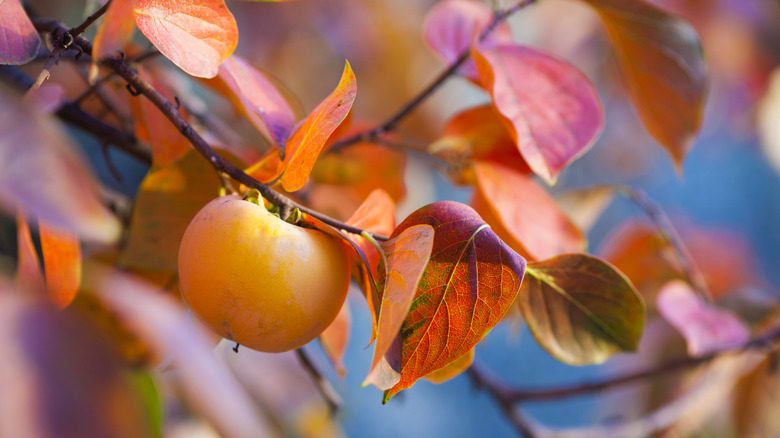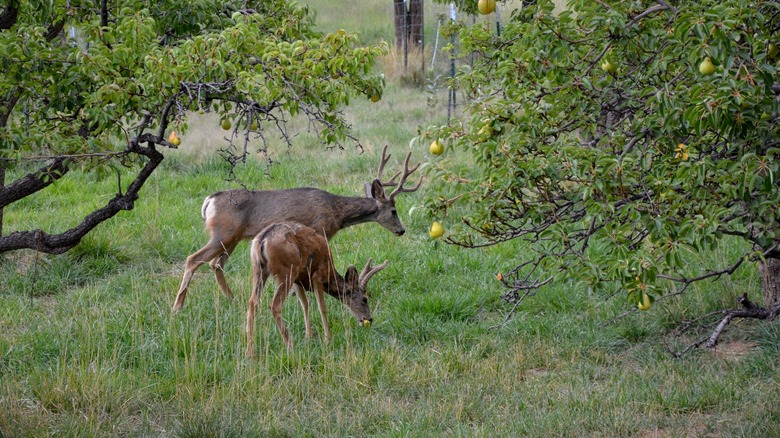Deer, with their graceful presence and gentle demeanor, are a sight many nature lovers cherish. However, attracting these majestic creatures to your property requires more than just good luck. It’s about understanding their dietary preferences and creating an environment that caters to their needs. Planting certain fruit trees is a fantastic way to lure them. However, there are literally thousands of different species of fruit trees. This article will uncover the classic ones that will make the wild deer go, “Oh deer, that’s delicious!”
First, let’s explore what exactly are deer’s gastronomical preferences. Deer are herbivores and browsers, meaning they primarily eat leaves, stems of woody plants, and other vegetation. However, their diet can be quite varied and adaptable depending on the environment and availability of food. Deer have a preference for softer, easier-to-digest foods, such as tender twigs, young leaves, and soft fruits. Bitter or very aromatic plants and tough, fibrous textures are off the table.
They are attracted to sweet flavors, which is why soft mast trees and plants that produce fruit are like a Michelin restaurant for deer. By providing this essential and nutritious food source, you’re supporting the local deer population, especially during harsher seasons when food is scarce. It’s important to note that deer’s eating habits change throughout the year. In the spring and summer, they prefer tender greens and will be drawn to the new growth on trees. In the fall and winter, their focus shifts to mast as they prepare for the colder months.
Apples, pears, and persimmons for deer

Apple trees are perhaps the most effective when it comes to attracting deer to your garden. The reason is simple: deer love apples. The sweet, crunchy fruit is a high-energy food source, especially vital in the fall when deer are building fat reserves for the winter. Additionally, apple trees often drop their fruit, making it easily accessible to deer. Sweet varieties like Anna Apple and Dorset Golden Apple are deer crowd pleasers.
Pear trees are another excellent option. Like apples, pears offer a sweet, nutritious snack for deer. Soft, ripe pears are easy for deer to eat and digest. Bartlett and Kieffer pears are popular choices, but it’s a good idea to plant a mix of varieties for a longer fruiting season. Different types of pear trees — including European, Asian, and Eurasian mixes — can be grown, with hybrids often being the best choice due to their resilience. It’s important to consider factors like fireblight resistance, climate zones, and fruit ripening dates when selecting pear trees to grow and care for in your garden.
Persimmons are a lesser-known but highly effective fruit for attracting deer, especially in the late fall. The common persimmon (Diospyros viginiana), native to the eastern United States, is particularly hardy and produces the sweet, delicious orange fruit that deer can’t resist. The fruit is initially bitter but becomes sweet and edible after the first frost — a period when other natural food sources are scarce. However, because persimmon trees are dioecious, only the female variety produces fruit.
More fruit trees and considerations for attracting deer

Crabapples are smaller and more tart than their domestic apple cousins, but deer enjoy them just as much. These trees are exceptionally hardy and can thrive in a variety of climates. Dolgo and Centennials are recommended varieties. Crabapples also provide a beautiful aesthetic appeal with their spring blossoms and colorful fall fruit.
Plum trees, with their sweet and juicy fruits, are an excellent option for deer. The American plum (Prunus Americana) is relatively easy to grow and maintain, making it a good choice for those new to fruit tree cultivation. It’s a perennial deciduous tree, growing up to 35 feet tall, that can thrive in various soils. The American plum produces fragrant white flowers in early spring, followed by edible red plums with bright yellow pulp that ripen in the summer.
While planting these trees can significantly increase the chances of attracting deer, there are other factors to consider. More than anything, the planting location and timing are crucial. The trees are best planted in a quiet area of your property, ideally in an open field edge and away from roads to reduce the risk of deer-vehicle collisions. It’s also vital to allocate a generous amount of space for your orchard. Installing deer-friendly fencing can protect young trees or other crops in your garden from being over-browsed.



